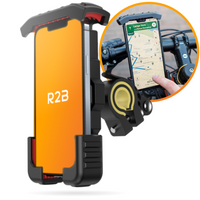No Products in the Cart

Why Doesn't a Touchscreen Work with Regular Gloves?
Time to read 3 min
Time to read 3 min
Anyone who tries to use their phone while wearing regular gloves in the winter knows the problem: the touchscreen simply does not respond. You can tap and swipe as much as you want, but the screen remains motionless. How is this possible? Why don’t touchscreens work with regular gloves? In this article, we explain how touchscreens work, why they usually only respond to bare skin, and what alternatives there are to still operate your phone while wearing gloves.
To understand why regular gloves don’t work on a touchscreen, it’s useful to understand how the screen works. Most modern smartphones use a capacitive touchscreen. This means that the screen responds to the electrical conductivity of your skin. Under the glass layer of the screen is a thin layer of a conductive material, often indium tin oxide (ITO). This layer creates an even electric field across the entire screen.
When you touch a capacitive touchscreen with your bare finger, this touch disrupts the electric field at that point. This disruption causes the phone to detect an electric charge and register it as a touch. The electric charge from your skin is therefore transferred to the screen, and this is essential for the screen to respond.
Capacitive touchscreens only work with conductive objects that can transfer the charge, such as human skin. Objects that don’t conduct electricity well—such as wood, plastic, or most gloves—are insulators. When you wear a glove, there’s a layer of material between your skin and the screen that blocks the current from passing through, so the screen doesn’t detect a touch.
Regular gloves are usually made of materials such as wool, cotton, leather or synthetic fabrics. All of these materials are insulators, which means that they do not transmit the electric charge from your skin to the screen. This explains why a regular glove cannot disrupt the electric field of the touchscreen. Without this disruption, the screen does not respond, just as if nothing has been touched.
However, there are ways to make gloves suitable for touchscreens. Here are some techniques that manufacturers use to make this possible:
Some gloves have conductive yarns or threads woven into the material, especially in the fingertips. These yarns are often made of metals such as silver or copper, which conduct electricity well. These threads allow some of the electrical charge from your skin to still reach the screen, causing the touchscreen to respond to your touch.
Another common method is to apply a conductive coating to the fingertips of the gloves. This coating acts as an extension of your finger, allowing the charge from your skin to pass through the glove to the screen. This is a simple and effective way to make gloves touchscreen compatible, without requiring the entire material to have conductive properties.
There are also gloves that are made entirely of conductive materials. This allows any part of your hand to operate the touchscreen, not just the fingertips. This type of glove is useful if you regularly use multiple fingers for typing or swiping, for example.
While touchscreen gloves are a great solution, not everyone has them on hand all the time. Luckily, there are a few creative ways to still operate your phone while wearing regular gloves:
Use your nose : This may sound funny, but your nose is just as conductive as your finger to operate the screen. It’s not the most elegant solution, but it works in an emergency.
Breathe on your screen or gloves : In cold conditions, a touchscreen sometimes doesn’t work because your fingers are too cold. Warming up your hands, for example by blowing on them, will help you operate the screen better.
Use a special stylus : Some styluses work well on touchscreens and can be a handy alternative if you're wearing gloves.
Make your gloves suitable yourself : With special conductive fabrics or threads you can modify existing gloves yourself. Applying a small amount of conductive fabric or thread to the fingertips can transform your gloves into touchscreen compatible gloves.
In principle, you can make almost any glove suitable for a touchscreen by adding conductive materials to it. For example, there are conductive liquids that can be applied to the fingertips of your gloves. It is also possible to sew conductive thread onto the fingers. Note that these DIY modifications are not always durable and can become less effective over time.
If you choose to make adjustments yourself, here are a few tips to increase effectiveness:
Use good quality conductive wire : Copper and silver are excellent choices for conductive wire.
Limit yourself to the fingertips : You only need to adjust the fingertips, since you will mostly use them to operate the screen.
Test your adjustment regularly : Touchscreen adjustments can wear out over time, so test your gloves regularly to ensure they are still working properly.

